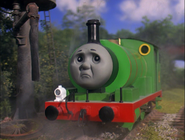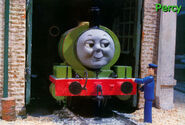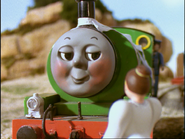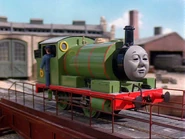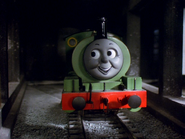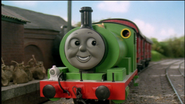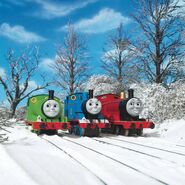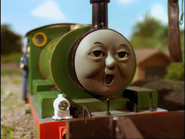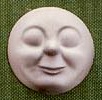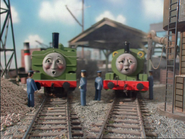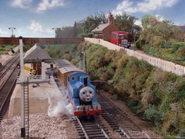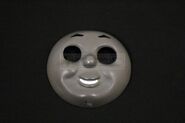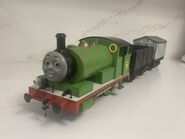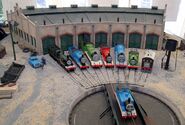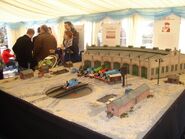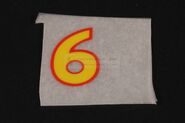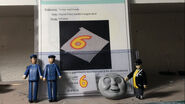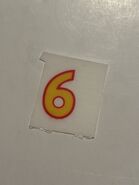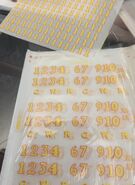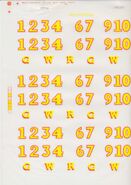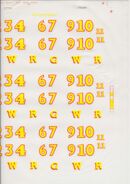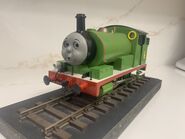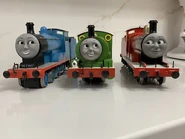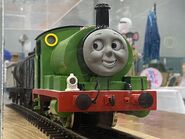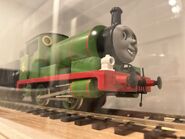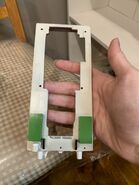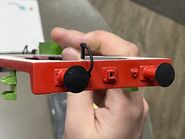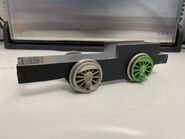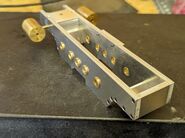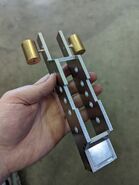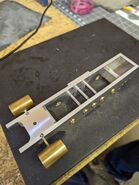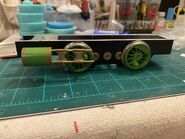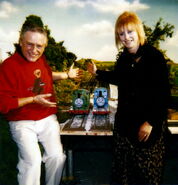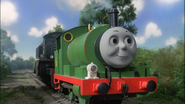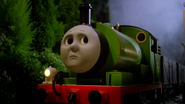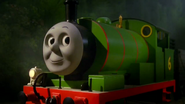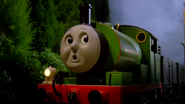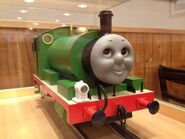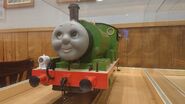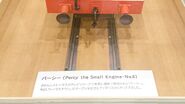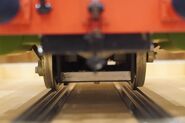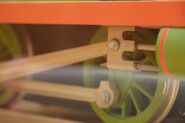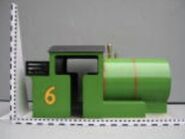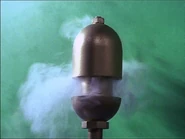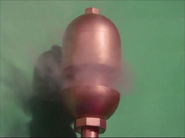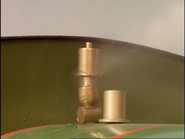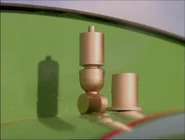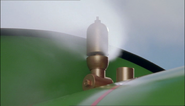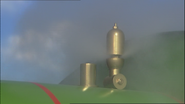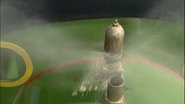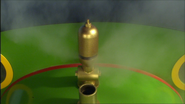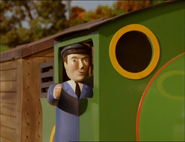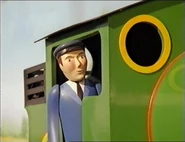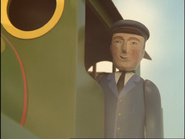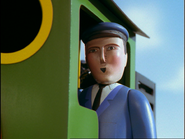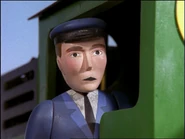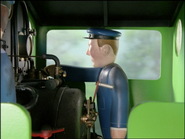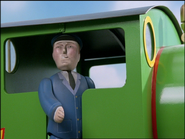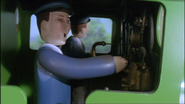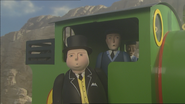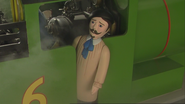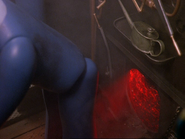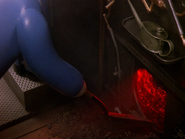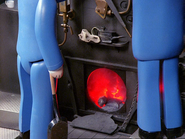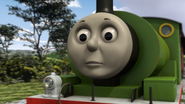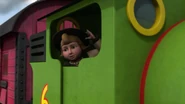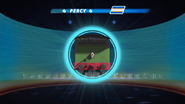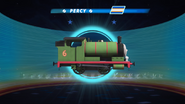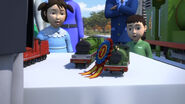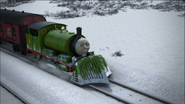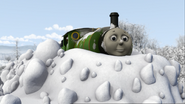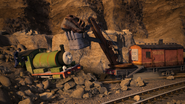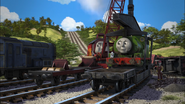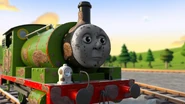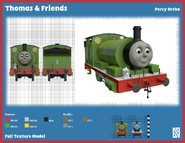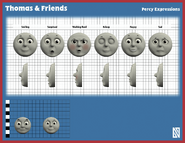
|
Background Information[]
Thomas & Friends[]
Percy is a fictional standard gauge saddle tank locomotive created by the Rev. W. Awdry. He is the No. 6 engine on the North Western Railway.
Percy first appeared in the first series episode Trouble in the Shed, which first aired in 1984. His last appearance was in the twenty-fourth series episode Thomas' Animal Friends, which was released in 2021.
In the Thomas & Friends television series, Percy is described as Thomas' best friend and is also one of the deuteragonists of the series, along with James.
Voice[]
Originally to be voiced by Michael Angelis in Thomas and the Magic Railroad, American test audiences claimed that he made Percy sound "too old". Linda Ballantyne voiced him in the final cut, giving Percy a faint British accent. Keith Wickham would later take over as Percy in the UK and Martin Sherman in the US, the former giving Percy a British accent and the latter American. Nigel Pilkington and Christopher Ragland would later take over their roles in 2015, giving Percy a British and American accent in their respective English dubs. As another note, Ragland and Pilkington's performances gave Percy a higher and softer voice, most likely to further distinguish him from Thomas, whose voice became bolder in pitch.
"Youngest" Engine?[]
Percy is the smallest member of the main group of engines, and is often described as the youngest or a junior member of the railway. Despite all this, in the original Railway Series, his exact build date is unknown.
Behind the Scenes[]
Gauge 1 models[]
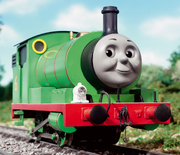
TATMR brass Percy model (Front)
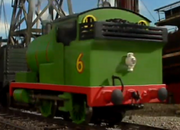
Series 1 plastic Percy model (Rear)
Percy's original model was custom built with a plastic body shell and used a Märklin locomotive as a donor for the chassis and various parts. It was painted using automotive paint and lined with red automotive pinstripe tape with the numbers being custom cut vinyl stickers. The model's boiler retained the "caterpillar" shape from C. Reginald Dalby's illustrations.
Percy's chassis was sourced from a gauge 1 locomotive made by Märklin, the BR 80. The chassis block itself was heavily modified for the wheel configuration for Percy's model. The inner connecting rod was spliced from the original BR 80 with the wheel configuration, and the piston rod was sourced from the BR 55 due to the BR 80's piston rod being too long for the chassis configuration. When he was first built, his front buffer beam was sourced from the tender of the BR 38, which was also the source of his toolboxes, but during the filming of the first series this was changed to a BR 55 tender beam. This may have been due to an accident on set while filming, but it is difficult to tell exactly when it was replaced due to the out-of-sequence method the series was shot in. His rear buffer beam was the rear beam from the BR 78 and was not replaced at the same time as his front beam.
Percy shared his spring design with Edward and James, but only used the very top of the box and the whole spring with end attachments that were removed for Edward and James. The source of these parts has not been matched with any pre-made model or kit, and they may have been scratch built.
Percy's plastic model was originally AC powered as this is how the Märklin locomotives were powered. During a refurbishment, his AC motor was replaced by a DC motor to allow for easier running and maintenance.
During the production of the second series episode, Percy and the Signal, Percy's model fell off the filming set, resulting in damage to both his left cylinder and centre lamp iron. While his centre lamp iron was hastily repaired with glue, his left cylinder kept wobbling up and down in various episodes, until both were properly fixed in the third series. However, the cylinder's repair became undone in the fifth series and can be visible in some episodes, specifically Toby and the Flood and A Surprise for Percy. Eventually, during the production of Thomas and the Magic Railroad, the model's cylinder was fully repaired.
In the second series episode, Ghost Train, the model was reused as Percy's Ghost Engine. The model was covered in white streamers to represent a ghost.
During the production of Thomas and the Magic Railroad, another model of Percy was built. This was due to the original model starting to show its age and having been repaired and repainted so many times that the crew were worried that some of these imperfections on the model would be seen on the big screen. The model needed to be in top condition to be used for intense filming.[1]
The new model was made out of brass and painted in a matte finish. It was equipped with a CNC machined brass chassis powered by a DC motor and the buffer beam details were built from scratch.
The original plastic model was also repainted in a matte finish and fitted with a new CNC chassis during the sixth series. The brass model did not receive a new CNC chassis until the eighth series. Around the start for the production of the sixth series, Percy's plastic model received a replacement brass roof much like James' plastic model. The plastic and brass models were used alongside each other for a number of years.[1] It should be noted that the plastic model's new wheels did not have counterweights, and this error would translate onto his tenth series brass model and his CGI model.
During the production of the tenth series, two new brass models of Percy were built. This was due to the plastic model being twenty-two years old at this point and the tight filming schedules meant there was very little room for emergency repairs. Unlike the rest of the plastic models, Percy's original plastic model was not used again after Calling All Engines and would be completely retired. When the brass models were built, to save costs in construction, one of the new brass models reused the original brass model's chassis with counterweights, as a result the original brass model was left without a chassis, so it reused the CNC chassis without counterweights used on the plastic model. The second model however, had its own dedicated chassis without counterweights.
The eye mechanism had two servos, one for up and down movement and one for left and right movement. The up and down servo was attached to the body. The left/right servo had a rod attached to the arm, which connected to a bracket. The eye balls were coupled to the bracket and locked in by the face-plate, so whenever the servos were powered, the eyeballs would move however the crew member desired.
Reference Sheets[]
Series 1[]
Series 2[]
Series 3[]
Series 8 (Brass Model)[]
Faces[]
Eighteen different facial expressions were sculpted for Percy, although only seventeen were used on-screen and one of which, an alternative astonished face was left unused. The faces were first sculpted in clay and from that resin casts were made using a silicone mould. Some of Percy's faces were duplicated in case the crew needed a face to look dirty and clean on the same day of shooting.
Reference Sheets[]
Usage and Evolution[]
Percy has been mistakenly given Thomas' tired face in the third series episode, Diesel Does it Again and the eighth series episode, Percy's Big Mistake.
Thomas has also been mistakenly given Percy's tired face in the first series episodes, Thomas Goes Fishing and Thomas and Bertie.
Present Day[]
Three of Percy's faces are now owned by Twitter and Instagram user ThomasTankMerch. A few of Percy's faces have also been displayed at the first and second Clearwater Events at the Midland Railway Centre in 2021 and 2022. Percy's smiling and yawning faces were also displayed at the two Tugs The Exhibition 10 Year Anniversary Events at the Midland Railway Centre in Spring and Autumn 2023.
CGI Face[]
The twelfth series marked the beginning of the show's transition into CGI, thus the characters' faces were animated through CGI with the aid of motion capture animation. The physical models' moulded faces were replaced by white targets with triangles to fix a computer-animated face in post-production. Percy's resin faces were only used in background shots.
Model Changes[]
Percy's gauge 1 models have gone through several aesthetic changes in the television series:
- Series 1 (only):
- The left side of his chassis had parts that hid the gears.
- Halfway through the series, his front buffer beam was replaced with a BR 55 tender beam.
- Series 2 (only):
- His left cylinder was loose and would shake violently when moving.
- His centre lamp iron was heavily glued on.
- His sidesteps became shorter.
- Series 3:
- His two front sandboxes were flipped around.
- His whistle sound changed pitch halfway through the series.
- He is painted in a slightly duller and darker shade of green.
- Series 4:
- His whistle sound changed back to its original pitch.
- His smokebox was raised up.
- One of the two black sections extending from under his smokebox to the end of the footplate is missing.
- He is painted in a slightly lighter shade of green.
- The ends of his crank pins were painted green.
- Series 5:
- He is painted in a slightly brighter shade of green.
- Thomas and the Magic Railroad:
- He gained a permanent lamp.
- His paint was given a matte finish.
- His whistle sound changed and shared it with Henry.
- He gained a smokebox saddle underneath his smokebox (both plastic and brass models).
- His smokebox saddle is painted green (plastic model).
- The lining on his pistons was moved slightly inwards.
- His eyebrows changed shape.
- His cab doors are open.
- His cab doors became wider (both plastic and brass models).
- His coupling rod bolts became silver again.
- The rivet detail on his front buffer beam disappeared (brass model).
- Series 6:
- His cab was blacked out (except for cab shots filmed on a close-up model).
- He regained his original whistle sound.
- The ends of his crank pins were painted green again.
- His smokebox saddle colour changed from green to black (plastic model).
- His counterweights disappeared (plastic model).
- The bearing and axle ends are visible on the sides of his CNC chassis.
- Series 10:
- His buffer housings became rounder (tenth series brass models).
- He gained brake pipe outlets (tenth series brass models).
- His saddle tank was lowered (tenth series brass models).
- His lamp became smaller (tenth series brass models).
- His funnel has more of a tapered edge (tenth series brass models).
- Chassis with counterweights and without were swapped around (TATMR and tenth series brass models).
- His front sandboxes became level to his rear sandboxes (tenth series brass models).
- His cab porthole windows became closer to the boiler (tenth series brass models).
Present Day[]
After production of the model series wrapped in 2008, most of the models and sets would be put into storage, with some being put on display at Drayton Manor Theme Park. All other models would be logged and referenced from 2010 until early 2011 by HiT Entertainment. From this HiT would decide on which models were to enter storage once again, which would be given to crew members and which would be disposed off. Due to its old age, Percy's plastic model would be disposed off, as it was no longer needed by the company since they had the brass models, which would stay under HiT and later Mattel's ownership. Briefly, one of Percy's brass models would also be exhibited on the Tidmouth Sheds set alongside the rest of the Steam Team at Drayton Manor for a special event during the same year.
Percy's Magic Railroad brass model is currently on display at the Hara Model Railway Museum in Japan. It had previously been on display at Nitrogen Studios. The model has the CNC chassis the plastic model used from the sixth series onwards. One of his tenth series brass models is currently in Mattel's storage unit in Southampton, England. The other brass model is likely in storage as well although this is unconfirmed. The brass model in storage has been discussed as a possible candidate to be put on display Drayton Manor Theme Park in 2023 by employees.[3] Although it would not be running. It was later decided a replica would be used instead if Percy was to be on the layout when the exhibition opened.[4] This however, never came to fruition.
A spare unused number decal for Percy is also currently owned by Twitter user Skarloey Railway Adventure. Another spare unused number decal would be sold by The Prop Gallery in 2023 which is now under ownership of Instagram, YouTube and Wikia user Wellsworth_Workshop. It was sourced from a spare unused larger decal sheet from the production of the eleventh series, which was then cut up and sold individually. Duplicate copies of this sheet are also currently owned by Twitter user TomsProps.
In November 2022, Percy's original plastic model, used from the first series to Calling All Engines!, was revealed to be owned and preserved by Twitter and Instagram user ThomasTankMerch. The model would be exhibited at the Greenberg's Great Train & Toy Show on 26 and 27 November in Edison, New Jersey.
Restoration[]
When first received, the model had its original Märklin buffer housings, hook mounting slot and triangular brake pipe plugs cut off and styrene pieces were placed over the original, now flat, plastic of the Märklin beam. The new triangular brake pipe plugs were incorrectly placed pointed downwards on the front where they used to be pointed up. It is unknown if this happened during or after the shows production when Percy's model was going through refurbishment. These all had to be removed and replaced with the correct pieces from a resin cast of a Märklin buffer beam. The cabs side window frames had some cracks which needed to be filled in. The model was missing its whistle and safety valve as the whistle hole had been filled in and painted over during an unfinished refurbishment, leaving behind a trace where the hole used to be on the boiler. A new 3D printed brass whistle was made and glued in place and the new safety valve was made from lathed brass and was glued in place next to the whistle.
The model also lacked a proper working chassis, as the original CNC chassis made for the model during the sixth series, was given to the Magic Railroad model during the tenth series. The model instead came with an acrylic mockup chassis based on the CNC chassis from the sixth series, possibly made to use as a temporary basis to replace the missing chassis during the tenth series. This chassis has two Märklin wheels and two CNC wheels. A new chassis has been made to replace the mockup chassis, which was measured to make a replica CNC type chassis to match the last on-screen appearance of the model. For the piston cylinders, the measurements were taken from a replica which were measured to make brass cylinders for the new chassis due to the mockup not having cylinders when originally received with Percy's model. The new chassis uses Märklin BR 80 wheels, a spliced BR 80 inner connecting rod, and BR 55 piston rods with nickel plated brass crossheads. The restoration work was done by Twitter users FlyingPringle, Cam's Replicas, and TDoc_41 respectively. However due to time constraints with the Edison show, the model's replacement chassis could not be motorised in time along with having a working eye mechanism reinstalled.
Gauge 3.5 model[]
During 1996, the production team were having discussions about scaling up the models to gauge 3.5 for the production of a possible theatrical film, this later becoming Thomas and the Magic Railroad. Models of Thomas and Percy were built to this scale for testing, but the production team ended up deciding to stick with the gauge 1 models. Percy's model was used for test footage, but the footage was never used in the end.
Percy's model would later be used alongside the models of the Sodor Construction Company vehicles, which had to be larger than the gauge 1 models in order in fit in all the components required for filming.
The model was made from brass. The wheels and chassis were custom machined (CNC). The model was track powered, so pickup contacts were attached to the metal wheels, which ran into the motor to power it. The electricity ran from the track to the wheels/pickup contacts and went into the motor to power him. The model was also fitted with a smoke unit.
The eye mechanism had two servos, one for up and down movement and one for left and right movement. The up/down servo was attached to the body. The left/right servo had a rod attached to the arm, which connected to a bracket. The eye balls were coupled to the bracket and locked in by the face-plate, so whenever the servos were powered, the eye balls would move however the crew member desired.
Six different facial expressions were created for the model, although only four were used on-screen and two of which his smiling and happy faces were left unused. The faces were first sculpted in clay and from that resin casts were made of a silicone mould.
In the twelfth series the physical model's moulded faces were replaced by white targets with triangles to fix a computer-animated face in post-production.
The model was used in the twelfth series, Jack and the Sodor Construction Company and The Great Discovery.
The gauge 3.5 model has had many modifications from its gauge 1 counterpart. These include:
- Jack and the Sodor Construction Company:
- The footsteps on his running board are painted red.
- His whistle is taller than his cab.
- His dome is painted green.
- The Great Discovery:
- The dome was repainted gold.
- Series 12:
- The footsteps are repainted green.
Present Day[]
The model is currently on display in Japan at Thomas Town with his unused happy face. In the past, it has also been exhibited at the Hara Model Railway Museum and Thomas the Tank Engine Exhibition.
Close-up models[]
A close-up model of Percy was built to be used for scenes where he had to interact with the close-up scale figures. In the first series, due to budget constraints, a close-up model of Percy was not built, so Percy's whistle used the whistle from Edward's close-up model placed against green vinyl, and the cab controls were reused from Thomas' close-up model.
A close-up model of Percy was eventually built in the third series. The model was made in pieces so it was able to be dismantled and reassembled when needed. Like most close-up models, Percy's model was not complete, only having a cab, coal bunker, whistle and parts of his boiler.
In the fifth series, Percy's close-up model received an overhaul, complete with a new cab exterior shell, custom cab controls and a new whistle. Sometime before or during filming of the sixth series, the sides of Percy's cab were damaged and repaired with rivets.
The close-up model later appeared in the seventh, eighth, ninth and twelfth series.
Whistles[]
Exterior[]
Interior[]
Present Day[]
Percy's close-up model is now currently owned by Twitter user TomsProps. Albeit in storage awaiting to be restored.
CGI model[]
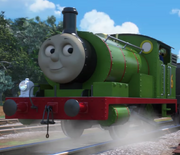

In 2009, the series introduced Computer-Generated Imagery (CGI) as a replacement for the show's long-standing live-action models. Percy was recreated from scratch in CGI by Nitrogen Studios. His model was "hand-sculpted" in Maya, a 3D animation and modelling software.
Photographs of Percy's Thomas and the Magic Railroad brass gauge 1 model were used for referencing. According Greg Tiernan, every detail of the original television series models for each character is carefully reproduced in the CGI model. The models are subjected to many rounds of review before they are submitted to HiT Entertainment for final input and approval.
Percy has had modifications throughout the CGI era. These include:
- Hero of the Rails:
- His cab became open again.
- He increased in size.
- The counterweights on his wheels vanished as his render was based on his tenth series brass model.
- Percy's whistle sound gained a secondary track for a harmonic echo effect.
- Sodor's Legend of the Lost Treasure:
- His side rods became silver.
- Series 23:
- He gained handrails on either side of his cab entrances and across his saddle tank like in The Railway Series.
- He gained holes on the fronts of his cylinders.
- He gained rivets across his saddle tank, the boxes on his sides, the sides of his roof, buffer beam front and sides and around his cab entrances, smokebox, his cylinder fronts and sides.
In the twenty-fourth series episode, The Great Little Railway Show, a modified version of Percy's CGI model was used to represent Wilbert Awdry's original OO scale model. Changes to the model include:
- The paintwork is given a more rough hand-painted texture.
- The lamps, lamp irons, rivets, stepladders, cab doors and rear cab side handrails are removed.
- His face is replaced by Kwaku's smokebox door.
- He is given a copper-capped chimney.
- His number is removed.
- His cab window portholes are painted green.
- He is given a gold bar in between his buffers, imitating the OO scale model's couplings.
- His handrails are moved further down his saddle tank.
Texture variants[]
In addition to his standard livery, several other texture variants exist of Percy's main CGI model. Many only appear once, however a few are reused multiple times. These texture variants include:
Pantone colours[]
The following pantone colours are used on Percy's CGI model:
- ■ PMS 116 (yellow)
- ■ PMS 361 (green)
- ■ PMS 428 (white)
- ■ PMS 485 (red)
- ■ PMS 873 C (gold)
- ■ PMS 877 C (silver)
Reference Sheets[]
Voice Actors[]
- Michael Angelis (Thomas and the Magic Railroad; original workprints only)
- Linda Ballantyne (Thomas and the Magic Railroad)
- Keith Wickham (UK; Hero of the Rails - Sodor's Legend of the Lost Treasure)
- Nigel Pilkington (UK; nineteenth - twenty-fourth series)
- Martin Sherman (US; Hero of the Rails - eighteenth series)
- Christopher Ragland (US; Sodor's Legend of the Lost Treasure - twenty-fourth series)
- Rob Rackstraw (YouTube shorts)
- Diana Santos (Latin America; Thomas and the Magic Railroad)
- Gabriel Gama (Latin America; Thomas and the Magic Railroad; TV version)
- Javier Olguín (Latin America; Hero of the Rails - The Great Race)
- Héctor Cuevas (Latin America; twentieth series - James the Super Engine)
- Armando Guerrero (Latin America; Nia's Bright Idea - Thomas' Animal Friends)
- Harold Salazar (Latin America; Thomas' Magical Birthday Wishes, Learning with Thomas and The Sodor Springtime Parade)
- María Rubio (Spain; Hero of the Rails - seventeenth series)
- Carmen Gambín (Spain; Tale of the Brave onwards)
- Bruno Marçal (Brazil; Hero of the Rails onwards)
- Reinder van der Naalt (The Netherlands)
- Frank Schröder (Germany; Thomas and the Magic Railroad)
- Christian Stark (Germany; twelfth series only)
- Robin Brosch (Germany; Hero of the Rails onwards)
- Achim Schülke (Germany; Audiobooks only)
- Anders Sundstedt (Norway; Hero of the Rails - seventeenth series, excluding King of the Railway)
- Erik Skjøld (Norway; King of the Railway onwards, excluding seventeenth series)
- Kim Sulocki (Sweden; Hero of the Rails onwards)
- Troells Toya (Denmark)
- Taisto Oksanen (Finland; Hero of the Rails onwards)
- Szokol Peter (Hungary)
- Bohuslav Kalva (Czech Republic; thirteenth series only)
- Radovan Vaculík (Czech Republic; seventeenth series onwards)
- Grzegorz Drojewski (Poland; Hero of the Rails onwards, excluding Samson at Your Service)
- Jarosław Domin (Poland; Samson at Your Service only)
- Olga Kuznetsova (Russia)
- Haris Grigoropoulos (Greece)
- Yehonatan Magon (Israel)
- Chisato Nakajima (Japan; first - eighth series)
- Chie Kōjiro (Japan; Calling All Engines! - twenty-fourth series)
- Um Sang-hyun (South Korea; twelfth (re-dub) - twenty-fourth series, Hero of the Rails (re-dub) to King of the Railway and Big World! Big Adventures!)
- Bang Ji-won (South Korea; Tale of the Brave - twenty-first series)









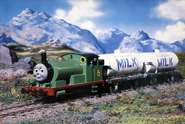

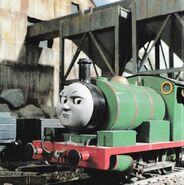







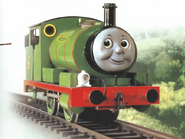



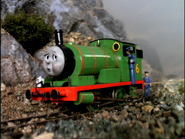
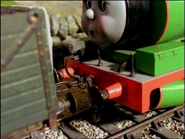



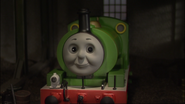
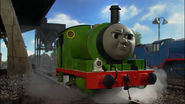




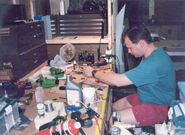



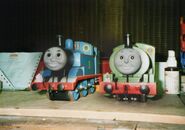

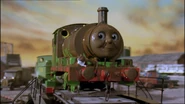
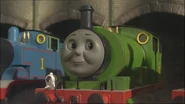

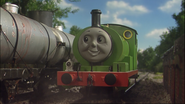
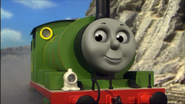
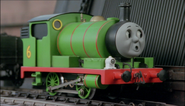



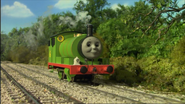
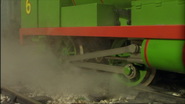
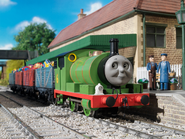







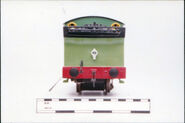
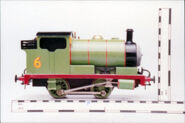




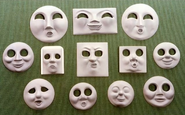
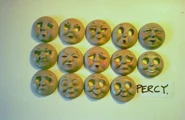

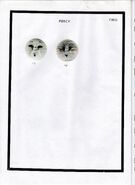
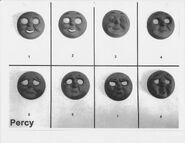

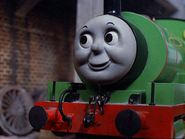
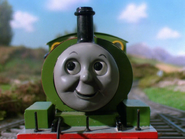


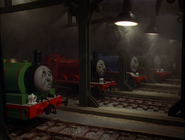



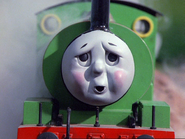

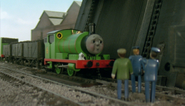

![Thomas,PercyandthePostTrain133.jpg (645 KB) ...and a deleted scene image from the third series episode, Thomas, Percy and the Post Train... (Early 1991)[2]](https://static.wikia.nocookie.net/ttte/images/a/a2/Thomas%2CPercyandthePostTrain133.jpg/revision/latest/scale-to-width-down/185?cb=20181231055758)







